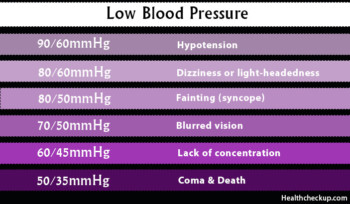
If you are experiencing symptoms of low blood pressure, you should contact your doctor. While there is no known cure, it can be a warning sign of more serious problems. A doctor can diagnose low blood pressure and recommend the best treatment. Symptoms of low body pressure are often caused by infection, including bacterial or fungal infections. The worst type is called septicemia and can damage organs. Some causes of low blood pressure are diverticulitis, pneumonia, urinary tract infection, and other bacterial or fungal infections.
The onset of low blood pressure can be triggered by a number of circumstances, including heart problems (heart failure or a heart attack), a long period of quiet standing, or an emotionally stressful event. Sometimes a person may fall or experience muscle pain. Some people may also experience confusion, dizziness, or headaches. If you suffer from these symptoms, it is best to eat small, low-carb meals.
Some medications, an allergic reaction, or a severe infection can cause your blood pressure to drop. Symptoms of low blood pressure can range from a mild headache to a dangerous drop in blood pressure. In severe cases, people can also have anaphylactic shock, which is an extreme case of hypotension. While this condition is rare, it’s worth seeing your doctor if you’re experiencing low blood pressure.
If you are experiencing low blood pressure, you should consider several different treatment options. A doctor may prescribe an antihypertensive drug to treat this problem. Other treatments listed on the health website satyayoga.com.sg
can help your blood pressure return to normal levels. It is important to consult with your doctor about a specific treatment plan. If you don’t want to see a doctor right away, try self-medication. You can take water tablets to rehydrate and reduce symptoms of dehydration.
The symptoms of low blood pressure are often temporary and may be the result of other conditions. In some cases, people may experience low blood pressure after sitting quietly for a long period of time. In other cases, it occurs after a sudden injury. A heart attack can cause a stroke or even heart failure. Some people may also experience symptoms of low blood pressure when they are suffering from anaphylactic shock. However, you should always consult your doctor before changing or adding salt to your diet.
The most common causes of Low Blood Pressure are heart problems. If you are having a heart problem, your blood pressure will be abnormal. You may need antibiotics or medicines to treat the problem. Your doctor can also prescribe a salt substitute or a rehydrating drink. Often, these two treatments are sufficient to treat low blood pressure. But it is important to discuss the symptoms with your doctor to determine the best course of treatment.
The symptoms of Low Blood Pressure can be caused by many factors. If you have a heart problem, your blood pressure will be very low. Some people with heart conditions will have symptoms of hypotension. If you suffer from a heart condition, your blood pressure will be very high. The symptoms of Low-pressure can also be caused by severe allergic reactions, bacterial infection, or anaphylactic shock. If you’re experiencing symptoms of Low-blood pressure, you should seek treatment immediately.
If you have symptoms of Low Blood Pressure, you should talk to your doctor. It is vital to make changes to your medication if you are suffering from the condition. Some medicines can increase or decrease your blood pressure, which is a sign of a heart problem. You should consult with your doctor before changing your medicine or adding salt to your food. Changing your position and resting will help your blood pressure return to normal. You should try to avoid any activity that can make your blood pressure drop.
The symptoms of low blood pressure are often accompanied by anaphylactic shock, a potentially life-threatening bacterial infection. It can also be caused by an injury or blood loss. Fortunately, most people who experience low blood pressure can sit down and rest. There are many treatments for the condition, but if the symptoms continue, you should contact your physician. If you have any of these symptoms, sit down and rest. The pain can be relieved by sitting.
